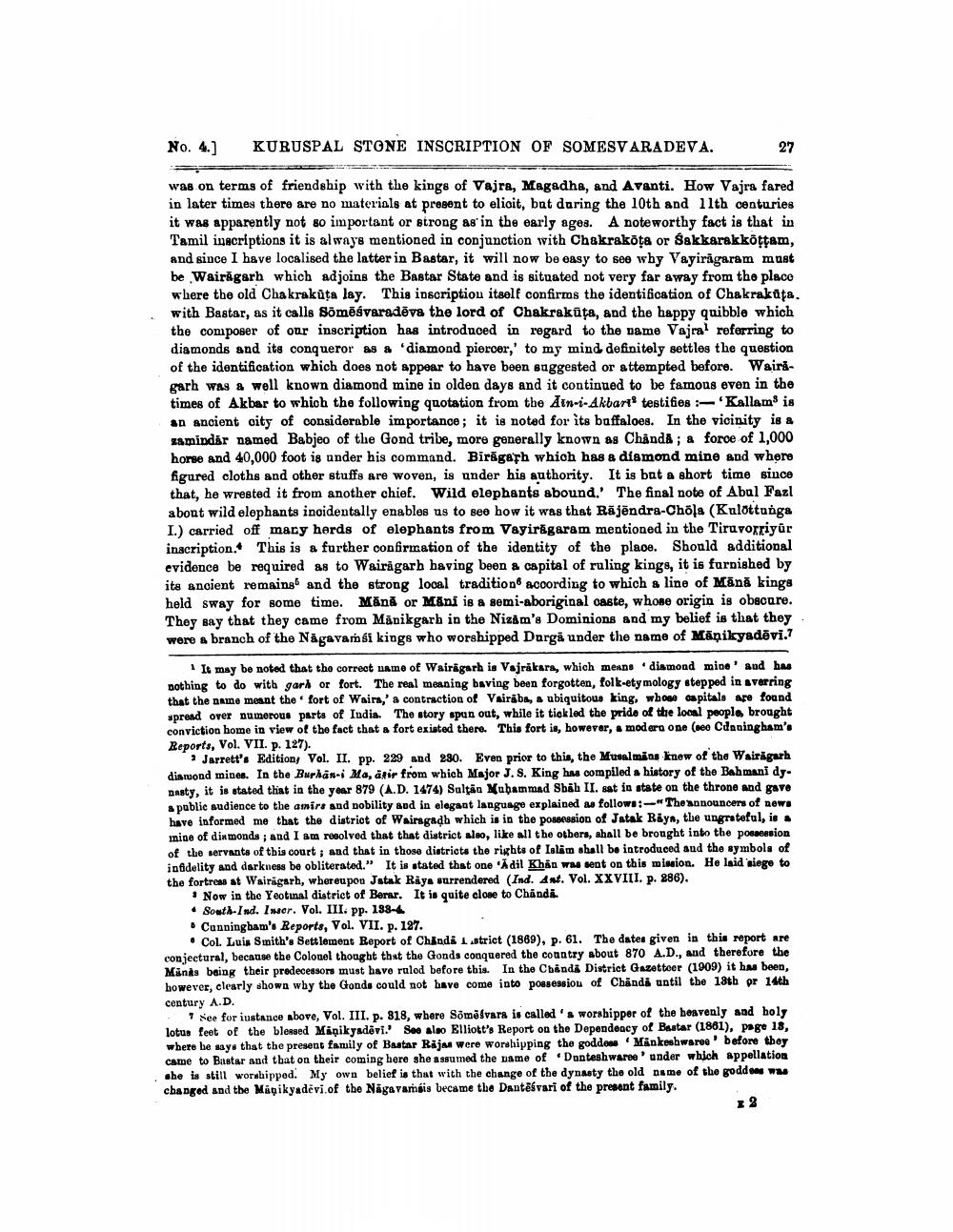________________
No. 4.)
KURUSPAL STONE INSCRIPTION OF SOMESVARADEVA.
27
was on terms of friendship with the kings of Vajra, Magadha, and Avanti. How Vajra fared in later times there are no materials at present to elicit, bat during the 10th and 11th centuries it was apparently not so important or strong as in the early ages. A noteworthy fact is that in Tamil inscriptions it is always mentioned in conjunction with Chakrakota or Sakkarakkottam, and since I have localised the latter in Bastar, it will now be easy to see why Vayiragaram must be Wairāgarh which adjoins the Bastar State and is situated not very far away from the place where the old Chakrakata lay. This inscription itself confirms the identification of Chakrakata, with Bastar, as it calls Sömēsvaradēva the lord of Chakrakūta, and the happy quibble which the composer of our inscription has introduced in regard to the name Vajral referring to diamonds and its conqueror as a 'diamond piercer,' to my mind definitely settles the question of the identification which does not appear to have been suggested or attempted before. Wairigarh was a well known diamond mine in olden days and it continued to be famous even in the times of Akbar to which the following quotation from the Ain-i-Akbart testifies 'Kallams is an ancient city of considerable importance; it is noted for its buffaloes. In the vicinity is & zsmiddár named Babjeo of the Gond tribe, more generally known as Chånd; a force of 1,000 horse and 40,000 foot is under his command. Birigach which has a diamond mine and where figured cloths and other stuffs are woven, is under his authority. It is but a short time since that, he wrested it from another chief. Wild elephants abound. The final note of Abul Fazl abont wild elephants inoidentally enables us to see how it was that Räjëndra-Chola (Kulottunga I.) carried off mary herds of elephants from Vayiragaram mentioned in the Tiruvorriyûr inacription. This is a further confirmation of the identity of the place. Shonld additional evidence be required as to Wairagarh having been & capital of ruling kings, it is furnished by its ancient remains and the strong local tradition according to which a line of Mānā kings held sway for some time. Mănă or Máni is a semi-aboriginal caste, whone origin is obscure. They say that they came from Manikgarb in the Nizam's Dominions and my belief is that they were a branch of the Nagavamsi kings who worshipped Durgå under the name of Māņikyadēvi.?
It may be noted that the correct name of Wairagarh is Vajräkare, which means diamond mine and has nothing to do with garl or fort. The real meaning baving been forgotten, folk-etymology stepped in a verring that the name meant the fort of Waira, a contraction of Vairsba, a ubiquitous king, wbos capitals are found spread over numerous parts of India. The story spun out, while it tickled the pride of the local people brought conviction home in view of the fact that a fort existed there. This fort is, however, a modern one (see Cdaningham's Reports, Vol. VII. p. 127).
Jarrett's Edition, Vol. II. pp. 229 and 280. Even prior to this, the Musalmias knew of the Wsiragarh diamond mines. In the Burhan-i Ma, ärir from which Major J. S. King has compiled history of the Bahmani dy. Dasty, it is stated that in the year 879 (A.D. 1474) Sultan Kubammad Sbih II. sat to state on the throne and gave a public audience to the amire and nobility and in elegant language explained as follows: "The announcers of news have informed me that the distriot of Wairagadh which is in the possion of Jatak Riya, the ungrateful, is . inine of diamonds; and I am resolved that that district also, like all the others, shall be brought into the possession of the servants of this court; and that in those districts the rights of Lolam shall be introduced and the symbols of infidelity and darkness be obliterated." It is stated that one 'Adil Khan was sent on this minion. He laid siege to the fortress at Wairigarh, whereupou Jatuk Raya surrendered (Ind. Ant. Vol. XXVIII. p. 286).
Now in the Yeotual district of Berar. It is quite close to Chandi • South-Ind. Inor. Vol. III. pp. 188-4 • Cunningham's Reports, Vol. VII. p. 127.
• Col. Luis Smith's Settlement Report of Chindi istrict (1869), p. 61. The dates given in this report are conjectural, because the Colonel thought that the Gonds conquered the country about 870 A.D., and therefore the Minks being their predecessons must have rulod before this. In the Chanda District Gazetteer (1909) it has been however, clearly showa why the Gronds could not have come into possessiou of Chånds until the 18th pr 14th century A.D.
I see for iustance above, Vol. III. p. 818, where Sömöfvars is called 's worshipper of the besvenly and holy lotus feet of the blessed Minikyadovi. See also Elliott's Report on the Dependency of Bostar (1861), page 18, where he way that the present family of Bastar Raju were worshipping the godde Minkeshwaree before they came to Bastar and that on their coming here she assumed the name of Dunteshwarve under which appellation she is still worshipped. My own belief is that with the change of the dynasty the old name of the goddess was changed and the Magikyadevi.of the Nagayam is became the Dantēsvari of the present family.
2




